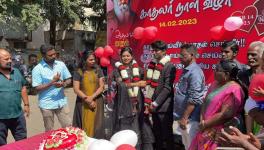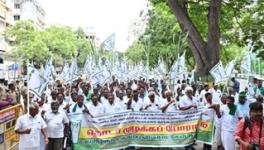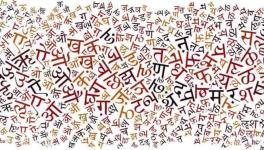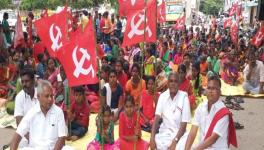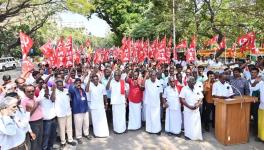Revisiting Caste Through Karnatic Music
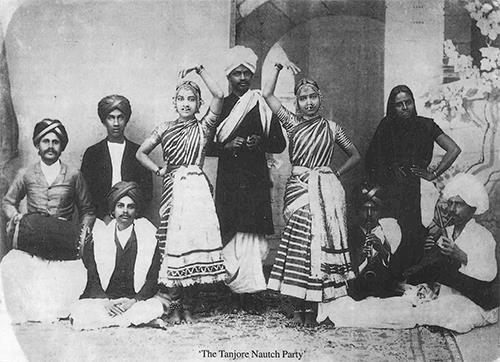
The Tanjore Nautch Party | Image Courtesy: Ateliers de'ethnomusicologie
Writer Volga’s Telugu translation of TJS George’s book M.S. Subbulakshmi: The Definitive Biography was recently launched in Hyderabad. Musician and writer T M Krishna spoke on culture and community, in effect contextualising the present day practice of Karnatic music and Bharatanaytam. Krishna raised pertinent questions about the appropriation of artistic practice by the brahmin community, and the loss of the body of traditional cultural practitioners from the isai vellalar community. He also asked, in this context, a question that cannot be wished away. M.S. Subbulakshmi’s iconic status is, without doubt, based on her music. But how much did her “sanskritisation” help make a musician who could “rise above caste”?
Krishna’s talk has led to a flurry of reactions. One common reaction has been a predictable one, i.e., an appeal to “not bring caste into music and the arts,” as if to say that not talking about the reality of caste power structures in cultural practice will make it all go away. Indeed, this has long been one of the means of glossing over the appropriation.
Another reaction—the rush of declarations of pride on social media, such as #IAmProudToBeABrahmin—has served to trivialise the discussion. To blame someone for being born a brahmin would be just as pointless as blaming someone for being born a dalit would be cruel. The worst practices of identity politics thrive on this kind of mindless gestures of pride or blame games.
What are the important questions that remain? There were, of course, interactions, transactions, as well as transfers of knowledge among castes in the case of Karnatik music. But what happened to the isai vellalar community in music? It is hardly enough to point to the usual handful of examples. How many survived the appropriation of the music by the brahmins? Where is the next generation of isai vellalar practitioners?
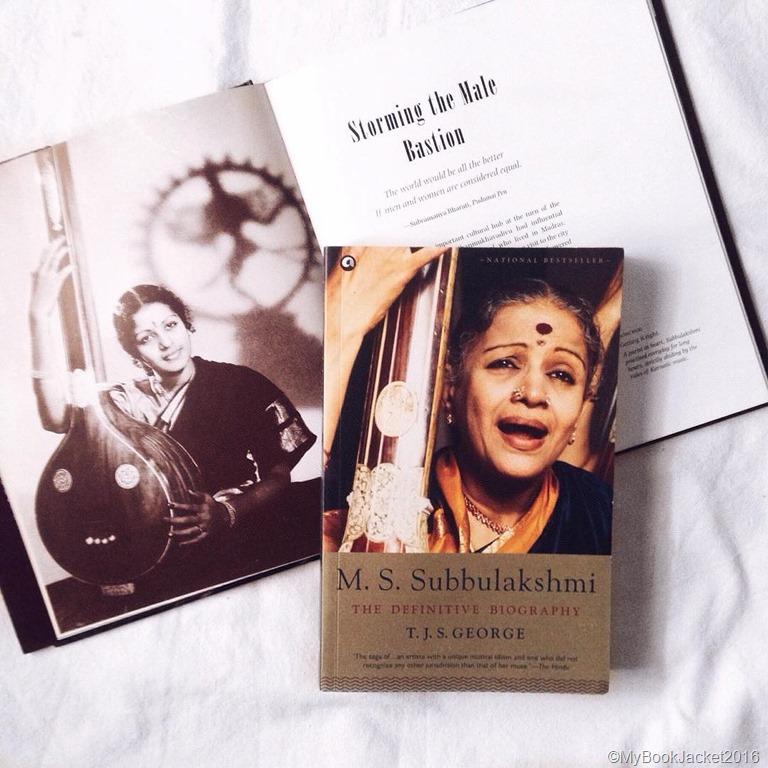
Our cultural practices can only be enriched by an honest attempt to understand how caste structures can create, and have created, exclusive spheres or the “island” or “gated community” that Krishna and others have referred to. To add a constructive voice to the discussion, the Indian Cultural Forum reproduces an extract from a conversation between TM Krishna and Githa Hariharan on some of the myths and realities of the classical and traditional nature of Karnatic music.
Githa Hariharan (GH): I want to ask you about the apparent conflation of “traditional” and “classical”. Would you say there is an illusion that current practice has a continuous link with “antiquity”? And that chunks of the “traditional” have actually been shed in the shift from traditional music and dance communities to a nationalistic Indian classical music?
T M Krishna (TMK): There is the image of Karnatik music, and there is the truth of Karnatik music. The image of Karnatik music practice traces its origins back over several centuries with a largely unchanged core character. Almost all theoretical and philosophical narratives of this musical form end at the doorstep of Bharata’s Natya Shastra (between 2nd centuries BC and AD), or pushing back to the Vedas themselves. Using a short ruler and a blunt pencil, we have drawn a single line from the ancient era to the 20th century. As with the theory of Hindu religion and philosophy, unconnected ancient musical traditions, counter-movements and deviations have all been fed into this linearisation, giving Karnatik music a sense of musical and philosophical “hoariness”, an antiquity.
But if we were to really look at the reality of its musical history through the treatises of the past, and what we know of its practice, it is quite clear that what we call Karnatik music today is a result of complex interactions between people of different regions and different musical lineages over the last 500 years. In its aesthetic evolution, what directly and incontestably connects the Karnatik with the music in the Natya Shastra, Silappadikaram (2nd century AD), Brhaddeshi (9th century) or the Sangita Ratnakara (12th century) is not much. Ideas embedded in theory and practices of periods much before the 16th century may have influenced some of the foundational principles of this melodic form. But beyond that, there is very little that connects Karnatik music as we know it today with the ancient world. Karnatik music is indeed a modern idea with its present form being only about 300 years old.
To come to its “communities”. Karnatik music has been practised, presented and patronised by the elite of South Indian society. What is “the elite”? Basically, the “select”, often self-selected, in positions of authority and influence. The communities that practised Karnatik music included the isai vellalars, the devadasis and brahmins. Isai vellalars and devadasis were part of the same musical community. Isai vellalars came in as vocalists, instrumentalists (nagasvara and tavil being a specialty), tutors of dance, and conductors of dance performances. Devadasis were dancers (performing sadir, which in the 20th century was transformed into Bharatanatyam), and musicians. The brahmins were involved in singing, instrumental music, composing, and the construction of Karnatik musicology. The brahmins, along with the royalty, used their positions of influence in temples and otherwise, to patronise and become the “blessers” of the form.
The revolving wheel of Karnatik music as we know it today was given another vigorous “turn” – an increasingly important one – by the upper-class Hindu nationalist movements of the late 19th and early 20th centuries. Their spirit transformed Karnatik music into a quasi-religious, bhakti-based presentation. Kirtana (a form of composition) became the anchor-sheet of the music, and its lyrical meaning became the basis for bhava in the music. The lyrical import being religious, philosophical and ritualistic, Karnatik music became a representation of brahmanical Vedic culture with “purity and sanctity” as a central notion. The influence of the brahmanical harikatha tradition, a musical storytelling of mythological stories that evolved in the Tanjore district during the Maratha period, cannot be underestimated in the evolution of 20th century Karnatik music. Many Karnatik musicians were also exponents of the harikatha tradition. So there is a cross-pollination of ideas in the content, presentation and stylisation of Karnatik music. The concert structure and presentation were the result of the structuring zeal of the urban brahmin male governed by these principles, with Madras becoming the hub.
It is around the same period that the devadasis lost their hold over the dance and music world with the “anti-nautch” legislation. The last generation of influential devadasi artists emerged in the early 20th century. Afterwards, things changed so much that some of these devadasis even shed their own identity to become brahmin women in the eyes of the Karnatik music fraternity. Musically, an independent feminine musical aesthetic was lost with the disappearance of the devadasis from the Karnatik cosmos.
The nagasvara vidvans who possessed a parallel instrumental narrative to Karnatik music were also slowly sidelined. They did try to conform to the kirtana-based musical presentation finalised by the early 20th century brahmin practitioners. But they were unable to establish themselves like their brahmin counterparts, who were vocalists or instrumentalists playing the flute or violin. The caste discrimination faced by nagasvara vidvans, including widely acknowledged maestros such as T.N. Rajaratnam Pillai, is part of Karnatik lore. Today the nagasvara is only found in temples or at marriage functions. There were isai vellalars who were violinists and mrdangists, and a few prominent vocalists. But they too faced distinct handicaps at social levels. Though the stature of their musicality had to be recognised, appreciation of their work did not mean they were accepted as “one of us”. Here again, the last generation of isai vellalar vocalists, violinists and mrdangists emerged in the 1940s. A lot of musical ideas were appropriated from the isai vellalars and the devadasis, but they were not made intrinsic to the 20th century “purified” Karnatik.
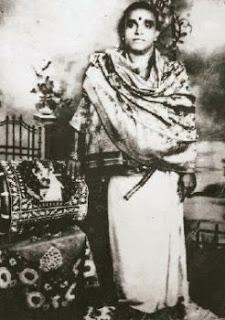
Tavil vidwan Needamangalam Meenakshisundaram Pillai | Image Courtesy: Sruti Magazine
With the isai vellalar and the devadasis more or less gone, the music came under the control of the brahmin community. Needless to say, this means the Brahmin males, with their own very particular sense of what was “proper”, what was “pure”, what was to go onstage, and what was to be kept away from it, with women being the special subject of taboos. Brahmin women themselves had to struggle against their “own men” for their right to be public performers. Only devadasis were meant “for the stage”, and “for the pleasure of others”. This social norm brings back the idea of devadasi impurity. To receive acceptance, talented brahmin women had to strictly follow the principles and restrictions laid out by the male Brahmins who designed 20th century musical practice.
GH: For those who don’t know much about “modern” Karnatik music, could you give us a brief background of the variety of exclusions in music practice on the basis of caste, gender and community? How do these exclusions actually work on the ground?
TMK: Today the Karnatik music world resembles a gated brahmin enclave. This includes practitioners, connoisseurs and impresarios. Most of the minority non-brahmin audiences come from the Tamil diaspora – from Jaffna and some (non-brahmin) communities from Kerala. Non-brahmin musicians today are mostly isai vellalars who continue in the nagasvara and tavil tradition. Very few come from other caste groups. A view contrary to this would lose no time mentioning names that “disprove” this. But those names are, essentially, the exceptions that not only prove, but shout out the rule.
The reason for this is plain. The performance and the articulation of Karnatik music is deeply entrenched in the brahminical ideas of religious practice. This is an intimidating cultural roadblock for most other caste groups. This subliminal undertone has very little to do with the music. It is more a social identity marker. But this construction is like an iron covering. It makes it very difficult for those not part of the brahminical environment to break through. The music is held captive to this Brahminism. It is also true that we wear this identity on our sleeves. Visit any of the Tyagaraja aradhana concerts, and you will see the overt manifestation of this ritualism embedded in the musical environment. It is almost as if you need to be anointed into this religiosity if you want to understand the music.
The places where the concerts take place – “sabhas” – are geographically public spaces, but culturally private conclaves. Most members of the inner circle don’t seem to understand that sabhas may have an “All are welcome” board outside, but this does not mean that it is a welcoming public space. I can only imagine what would happen if suddenly, one day at a concert, most seats were occupied by people of a Chennai slum. This would certainly make every person, including the musicians, extremely uncomfortable. Therefore this “All are welcome” actually addresses the “All” of a certain cultural community and we do not want “All and sundry” to come in. Being welcoming is very different from saying we don’t stop anyone!
Today there are very few instrumentalists or vocalists who are not brahmin. And even those have not really made it to the top rung of the musical ladder. Saxophone Kadri Gopalnath and the late Mandolin U. Srinivas are two musicians from outside the brahmin fold who broke the “B” barrier. Interestingly, both of them took up western instruments – the electric mandolin and saxophone. I wonder whether the elitism of their “western instruments” somehow helped them break through the casteism in the Karnatik substratum.
Without doubt, we brahmin practitioners have a different attitude towards the “others”. This separation is seen in the way musicians bond and share beyond the stage. It is in these spaces one can clearly see groups forming with the non-brahmin musicians (usually isai vellalars) almost always in a different group from their brahmin colleagues. It is also true that the few people of other castes, whether they are practitioners or listeners, have had to internalize the brahminical texture of Hinduism which we believe gives Karnatik music depth and direction.
We can clearly see this in the way Tamil Nadu’s music colleges stay apart from the general Karnatik music scene. These music colleges are where the maximum number of non-brahmin students study Karnatik music, yet few of them ever make it to the mainstream circuit. In fact, there is very little connection between us the “control group” and those students. They remain in the periphery, and most of them disappear.
We, as the control group, have done little to make this music more accessible. Nor have we consciously considered accepting students from other communities. I do believe that such affirmative action is essential. Very importantly, we should look at communities beyond even the traditionally musical isai vellalars so that this music may touch a larger cross-section of society. The traditional notion that the “classical” (a purely sociologically created term), can only be appreciated by a certain class of people, needs to be challenged.
Digging this music deeper into the Hindu belief system has also made it very difficult for people of other religions to come into the system. A few traditional Muslim musical families that have produced nagasvara vidvans have made brahminical religious practices a part of their lives. This only strengthens the religious rigidity that informs the music. I wonder whether a devout Muslim who rejects the Hindu would be acceptable to us.
In the early 20th century, some attempts were made by Christian scholars such as Abraham Pandithar and H.A. Popley to create Karnatik kirtanas with Christian themes, but these compositions are not even known to the mainstream Karnatik community. K.J. Yesudas is frequently cited as an example of the openness of the Karnatik world. But the “real” Karnatik fan does not accept Yesudas as a serious musician. In fact, if you were to attend his concerts, you would find that the members of the audience are distinctly different from the people you would find at the concerts of many accepted Karnatik musicians.
The gender bias in Karnatik music is blatant and obvious. Many senior musicians who accompany vocalists on the violin or mrdangam, including many leading lights, have refused and continue to refuse to “accompany” women musicians. Accompanying women singers is acceptable up to the point when leading male vocalists induct these violinists and mrdangists into the “men’s club”. In fact, many male vocalists have told accompanying male musicians that they should stop accompanying women, or not do it too often, if they want the patronage of the leading men! Organizers too play along with the wishes of the men. The common talk among the male musicians is that in general, women’s music is not as tough and rigorous as “men’s music”. Accompanying musicians claim that the women do not “challenge” them. Other arguments include complaints from accompanists that the high pitch of women’s voices makes the strings of the violin and the membranes of their mrdangam taut, so that it is hard to freely express themselves. Of course, this argument flies out of the window because these very same musicians accompany male instrumentalists who tune their instruments to the very same high pitches. The point is that there is a clear disdain for “women’s music”, and such generalizations are, let us face it, purely sexist. For a woman to receive respect from the men she has to indulge in complicated mathematical or technical musical presentations, traditionally considered the man’s domain, too difficult for the “weaker sex”! Another effect of influential musicians only accompanying “the boys” is that young women do not get the professional support of these stars, while the young men of their generation are able to reach the top tier with greater ease. Ironically, even female star lead-musicians prefer to have male accompanists. Like their male counterparts, they are “fine” with female accompanists until they become stars. Once that happens, they prefer male accompanists whom they can control, and display the same machismo their male counterparts flaunt. The officialdom of Karnatik music is also a male bastion, making the environment quite difficult for women in general.
GH: You once used a telling metaphor about access to Karnatik music today, its “exclusiveness”. You likened this music world to an island that people in the mainland are cut off from. How is this transforming the development of music practice, and the alleged “Indianness” (as in pluralistic) nature of the “tradition”?
TMK: Though Karnatik music has by and large been an elitist art form, the sense of cultural exclusivity that we practise today has sharpened over the last 100 years or more. We hold, at the core of Karnatik music practice, the philosophical un-questionability of the Vedic tradition. This idea envelops our complete understanding of the form. Once we describe this music in such terms, we make lyrics and their linguistic meanings central to the experience of the music. This makes us overburden musicality with artha-bhava, which, to me, has very little or no space in an art form such as Karnatik music. But this has greatly influenced the way this music is practiced and experienced. Consider the numerous so-called Karnatik music PhDs awarded for religious topics, religious theme based concerts/presentations and esoteric lec-dems proliferating in the Karnatik sphere. From being an abstract exploration of raga, tala and text, the music has become a creative extension of bhakti sangeet! The number of purely bhajan-like pieces in the concert has increased over the last 40 years, with many members of the audience only waiting for that religious or spiritual upliftment. My point is that there is no place for religious or spiritual directionality in this music. In fact, there is no room for any literalism.
In all this religious entrapment we have lost the purely abstract musicality – the soul of the music. We are unable to experience language as a creation of sound and its aesthetic interactivity with raga and tala. Every one of us experiences this beauty, yet we constantly bury it inside a religious/spiritual discourse. And that discourse is almost canonical.
But my own thoughts on how to address this issue has changed over the years. For long I held on to the abstract vs literal argument. But soon realised that I need to nuance this discussion. I now feel we first need to create multiple profundities using the semantic of language itself. Instead of only singing on gods and goddesses, we should bring in compositions that deal with societal ideas in a contemporary sense. Songs on farmers, the struggle of women, nature, cities, people, other religions, protest, voices from different sections of society and ideas that we are unfordable with. If audiences begin experiencing ‘divinity’ even in these songs that will be an important shift. From here moving to the point where the linguistic meaning becoming inconsequential is a real possibility. Which is why I am constantly working on my repertoire.
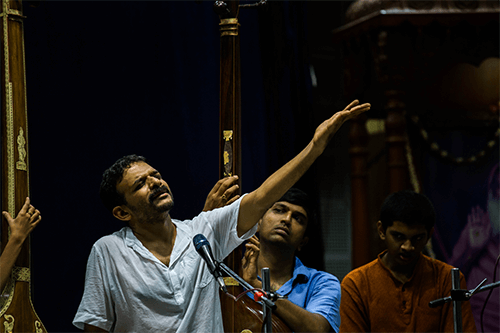
There is another trap in this religious-spirituality. We, the practitioners of Karnatik music, believe that we are singing a sacred form of music that rises above everything tactile and temporal. We give ourselves the status of being conduits to the divine. This self-created and self-appointed position allows us to ignore the very real discriminative nature of our musical practice, by saying that “music is beyond all this” or “once ‘in music’ all these separations don’t matter.” We feel we shouldn’t distract ourselves with such externalities. So we forget that the very idea of the internal is the result of these external manipulations.
Get the latest reports & analysis with people's perspective on Protests, movements & deep analytical videos, discussions of the current affairs in your Telegram app. Subscribe to NewsClick's Telegram channel & get Real-Time updates on stories, as they get published on our website.











